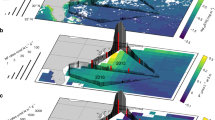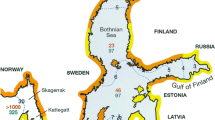Abstract
Blooms of planktonic cyanobacteria occur in oligotrophic tropical and sub-tropical oceans and in the Baltic Sea. Intense N2 fixation during blooms may provide large inputs of new N to these waters. However, the temporal and areal extent of the blooms and the quantitative significance to upper ocean C and N cycling, while suspected to be high, remain unknown. Recently, several independent lines of research have concluded that open ocean N2 fixation, one component of new N input, may have been severely underestimated, and this may have been due to the difficulty in quantifying blooms.
Studies on the ecology and physiology of these bloom-forming cyanobacteria in the Baltic and tropical seas have proceeded with little previous scientific interchange between their respective researchers. The application of modern technologies, including molecular biological techniques and remote sensing (among others) has accelerated the pace of effort in each realm. The impetus for assessing the larger scale implications of N2 fixation in each system has yielded obvious parallel research themes and common questions. For instance, there is yet no clear consensus on the factors or circumstances leading to bloom formation, or of the fate of recently fixed N in either system.
In view of the recent increase in research, the diverse but often common nature of the investigations, and the wide geographic range of these bloom-forming cyanobacteria, it was timely that a comparison and synthesis of knowledge be made, and that future directions in research be charted. Hence, with support from NATO and the US NSF, an Advanced Research Workshop (ARW) was held in Bamberg, Germany, from May 26 to May 31, 1991 with the objective of discussing the comparative ecology and physiology of bloom-forming N2 fixing cyanobacteria in the sea.
The ARW brought together about 40 researchers from twelve countries to review and compare results from their respective areas and to develop an integrative framework for future coordinated research. The meeting promoted unique scientific interactions and exchanges across disciplines (molecular to megascopic levels) and between systems (tropical and temperate cyanobacteria), helped identify common questions, and stimulated cross-fertilization of ideas and approaches.
Access this chapter
Tax calculation will be finalised at checkout
Purchases are for personal use only
Preview
Unable to display preview. Download preview PDF.
Similar content being viewed by others
References
Capone, D.G. and Carpenter, E.J. (1982) ‘Nitrogen fixation in the marine environment’ Science 217, 1140–1142.
Capone, D.G (1991) ‘Aspects of the marine nitrogen cycle with relevance to the dynamics of nitrous and nitric oxide’ in W.B. Whitman and J.E. Rogers (eds.), Microbial Production and Consumption of Radiatively Important Trace Gases, Am. Soc. Microbiology Special Publication, Washington, D.C., pp. 255–275.
Capone, D.G., O’Neil, J.M., Carpenter, E.J. and Zehr, J. (1990) ‘Basis for diel variation in nitrogenase activity in the marine planktonic cyanobacterium, Trichodesmium thiebautii’, Appl. Environ. Microbiol. 56, 3532–3536.
Carpenter, E.J. (1983a) ‘Nitrogen fixation by marine Oscillatoria (Trichodesmium) in the world’s oceans’, in E.J. Carpenter and D.G. Capone (eds.), Nitrogen in The Marine environment, Academic Press, N.Y., pp. 65–103.
Carpenter, E.J. (1983b), ‘Physiology and ecology of marine Oscillatoria (Trichodesmium)’ Marine Biol. Lett. 4, 69–85.
Carpenter, E.J. and McCarthy, J.J. (1975), ‘Nitrogen fixation and uptake of combined nitrogenous nutrients by Oscillatoria (Trichodesmium) thiebautii in the western Sargasso Sea’, Limnol. Oceanogr. 20, 389–401.
Carpenter, E.J. and Price, C.C. (1976), ‘Marine Oscillatoria (Trichodesmium): explanation for aerobic nitrogen fixation without heterocysts’, Science 191, 1278–1280.
Carpenter, E.J. and Price, C.C. (1977), ‘Nitrogen fixation, distribution, and production of Oscillatoria (Trichodesmium) in the northwestern Atlantic Ocean and Caribbean Sea’, Limnol. Oceanogr. 22, 60–72.
Carpenter, EJ., Chang, J., Cottrell, M., Schubauer, J., Paerl, H.W., Bebout, B.M., and Capone, D.G. 1990. ‘Re-evaluation of nitrogenase oxygen-protective mechanisms in the planktonic marine cyanobacterium Trichodesmium.’ Mar. Ecol. Prog. Ser. 65:151–158.
Devassy, V.P., Bhattathiri, P.M.A. and Qasim, S.Z. (1978), ‘Trichodesmium phenomenon’, Indian J. Mar. Sci. 7, 168–186.
Eppley, R.W. and Peterson, B J., (1979), ‘Particulate organic matter flux and planktonic new production in the deep ocean’, Nature 282, 677–680.
Howarth, R. and Cole, J. (1985), ‘Molybdenum availability, nitrogen limitation, and phytoplankton growth in natural waters’, Science 229, 653–655.
Howarth, R., Marino, R. and Cole, J., (1988), ‘Nitrogen fixation in freshwater, estuarine and coastal marine ecosystems. 2. Biogeochemical controls’, Limnol. Oceanogr. 33, 688–701.
Karl, D., Letelier, R., Bird, D., Hebel, D., Sabine, C. D. and Winn, C. (1990), ‘An Oscillatoria bloom in the oligotrophic North Pacific Ocean near the GOFS station ALOHA. EOS 71:177 (OS51C-3).1.
Larrson, U., Elmgren, R. and Wulff, F. (1985), ‘Eutrophication and the Baltic Sea: causes and consequences’, Ambio 14, 10–14.
Legendre, L., and Gosselin, M. (1989), ‘New production and export of organic matter to the deep ocean: Consequences of some recent discoveries’, Limnol. Oceanogr. 34, 1374–1380.
Martinez, L. Silver, M.W., King, J.M. and Alldredge, A.L. (1983), ‘Nitrogen fixation by floating diatom mats: a source of new nitrogen to oligotrophic ocean waters’, Science 221, 152–154.
McCarthy, J.J. and Carpenter, E.J. (1983), ‘Nitrogen cycling in near-surface waters of the open ocean’, in E.J. Carpenter and D.G. Capone (eds.), Nitrogen in the Marine Environment. Academic Press, New York, pp. 487–512.
Paerl, H. (1989), ‘Physiological ecology and regulation of N2 fixation in natural waters’, in. K. Marshall (ed.), Adv. Microbial Ecol. Vol. 11, Plenum, N.Y., pp. 305–344.
Ryther, J.H. and Dunstan, W.M. (1971), ‘Nitrogen, phosphorus and eutrophication in the coastal marine environment’, Science 171, 1008–1012.
Waterbury, J.B., Watson, S.W., and Valois, F.W. 1988. Temporal separation of photosynthesis and dinitrogen fixation in the marine unicellular cyanobacterium: Erythrosphaera marina. EOS 69:1089.
Zehr, J.P. and McReynolds, L.A. (1989), ‘Use of degenerate oligonucleotides for amplification of the nifH gene from the marine cyanobacterium Trichodesmium thiebautii, Appl. Envir. Microbiol. 55, 2522–2526.
Author information
Authors and Affiliations
Editor information
Editors and Affiliations
Rights and permissions
Copyright information
© 1992 Springer Science+Business Media Dordrecht
About this chapter
Cite this chapter
Capone, D.G., Rueter, J.G., Carpenter, E.J. (1992). Overview of the Advanced Research Workshop on Bloom-Forming Marine Cyanobacteria. In: Carpenter, E.J., Capone, D.G., Rueter, J.G. (eds) Marine Pelagic Cyanobacteria: Trichodesmium and other Diazotrophs. NATO ASI Series, vol 362. Springer, Dordrecht. https://doi.org/10.1007/978-94-015-7977-3_1
Download citation
DOI: https://doi.org/10.1007/978-94-015-7977-3_1
Publisher Name: Springer, Dordrecht
Print ISBN: 978-90-481-4126-5
Online ISBN: 978-94-015-7977-3
eBook Packages: Springer Book Archive




